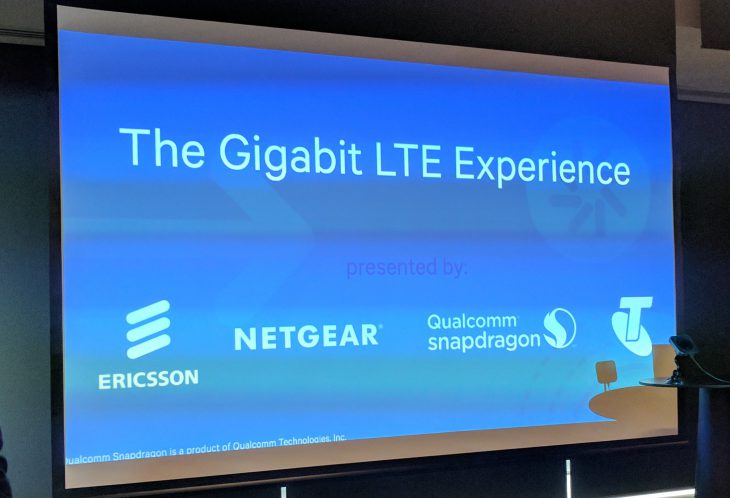
While the promise of 5G connectivity is fast approaching the new standard is yet to be agreed upon, let alone rolled out. That hasn’t stopped Telstra leading the world with the first live Gigabit LTE connectivity. We got to spend the day as a guest of Qualcomm at Telstra’s Sydney experience centre and went hands-on with the new network.
In short, it’s fast, lightning fast, on a dedicated connection without any competition for traffic, so dedicated cell node and a single device on the network, I saw a live demo with downloads speeds ranging from about 860 – 930 Mbps and uploads in the 100 – 120 Mbps range, that’s fast. Of course, this isn’t what the majority of the users will experience but shows just how impressive the underlying technology is.
In some far more real world tests, we went through a series of demos from mobile upload and download tests, downloading hi-res images from Google Drive to a PC, to 5 x simultaneous 4K Daydream View streams including a live stream from the Opera House and a 4K video streaming. All of these tests were running concurrently off 4 different Cat16 LTE hotspot devices all competing on the public cell tower.
Based on these speeds and what we observed today with a Gigabit LTE connection you could expect to:
- Download a typical 3.5 MB song in a fraction of a second
- Download a 20MB PowerPoint presentation in as little as one second
- Download a 300MB one hour TV episode in as little as sixteen seconds (I saw and timed this first hand)
- Download a 3GB HD Movie in as little as 3 minutes
During these test, we saw real-world download speeds in excess of 150 Mbps and upload speeds around the 88 Mbps range. Those real-world speeds rival the speeds of most people’s NBN connections and would smash the speeds of anyone’s legacy hardwired internet speeds.
Benefits of LTE Gigabit
The first benefit is obvious, speed, pure speed, did I mention the speed? Obviously, speed brings the advantage of things happening quicker, want that 1GB download? Great here it is much faster, but if you look beyond that there are other benefits.
Firstly is decreased mobile congestion, if the network can move more bits more quickly people will be on and off the network quicker leaving more connections available. The example given was a busy convention or sporting event where each user would need only a fraction of the time on the network to meet their connectivity needs.
Another benefit is increased battery life because the data transfers quicker the device needs to use less time and thus battery life to spin up the modem, antenna, CPU etc. This is slightly offset by a higher power usage but apparently, the net outcome is a power saving, and who doesn’t want more power.
While the X16 LTE speed is a major component of the new technology, it’s not the only component. Other network technologies including 4 X MIMO and 256 QAM, which is too complex to go into here, will see incremental improvements in network performance outside any rollout of x16 LTE compatible towers.
The long term benefit of Gigabit LTE will be building the backbone of the 5G failover network. The 5G specification as it currently stands will support dual connectivity allowing devices to be concurrently connected to both the 4G and 5G networks allowing for seamless fallback if your future 5G connectivity fails or is patchy.
When will we get it?
While details of a future Australian rollout of Gigabit over LTE will be sometime in mid-February, if everything stays on schedule, what we do know is that if you’re in or near the CBD of Brisbane, Sydney or Melbourne the network in those areas have already been upgraded to support the new LTE speeds.
For those in Perth and Adelaide, the CBD rollout is expected to be completed by the end of 2017. For the rest of us, Telstra’s current roadmap isn’t set, according to a representative Telstra will “roll out the network appropriately”. Long story short, the rollout will follow population densities and network congestion just like previous rollouts have.
However, as discussed above there are other components of the technology including 4×4 MIMO and 256 QAM will extend benefits to more of the network as those upgrades are rolled out to existing infrastructure. This should mean that even if you’re not in the rollout zone you should experience more reliable connectivity and potentially increase speeds.
At launch, Gigabit LTE will only be available to the new Netgear Nighthawk M1, which in itself is a fantastic little device. However, going forward any device that implements the Snapdragon 835 (or above) or the x16 model both from Qualcomm will technically be capable of Gigabit on LTE if the OEM implements it.
With the Australian NBN being a bitter disappointment in both rollout timeframes and real word network speed perhaps Gigabit LTE and 5G after that may just offer the kind of connectivity Australia has been offered but rarely delivered?





Let’s start talking about revolutionising mobile data prices and caps before we get too excited about super fast service, shall we?
“With the Australian NBN being a bitter disappointment in both rollout timeframes and real word network speed perhaps Gigabit LTE and 5G after that may just offer the kind of connectivity Australia has been offered but rarely delivered?”
What a depressing, yet utterly true, statement. Which probably wouldn’t have been made if the LNP hadn’t stuffed up the NBN so much with their multi-technology mix.
Add that to the list of what we want to see in the next pixel phone.
If it’s got the SD835 I bet it will support it
I won’t settle for anything under an SD840 in the next pixel.
Proper high end device.
And a 5,000 jigawatt battery.